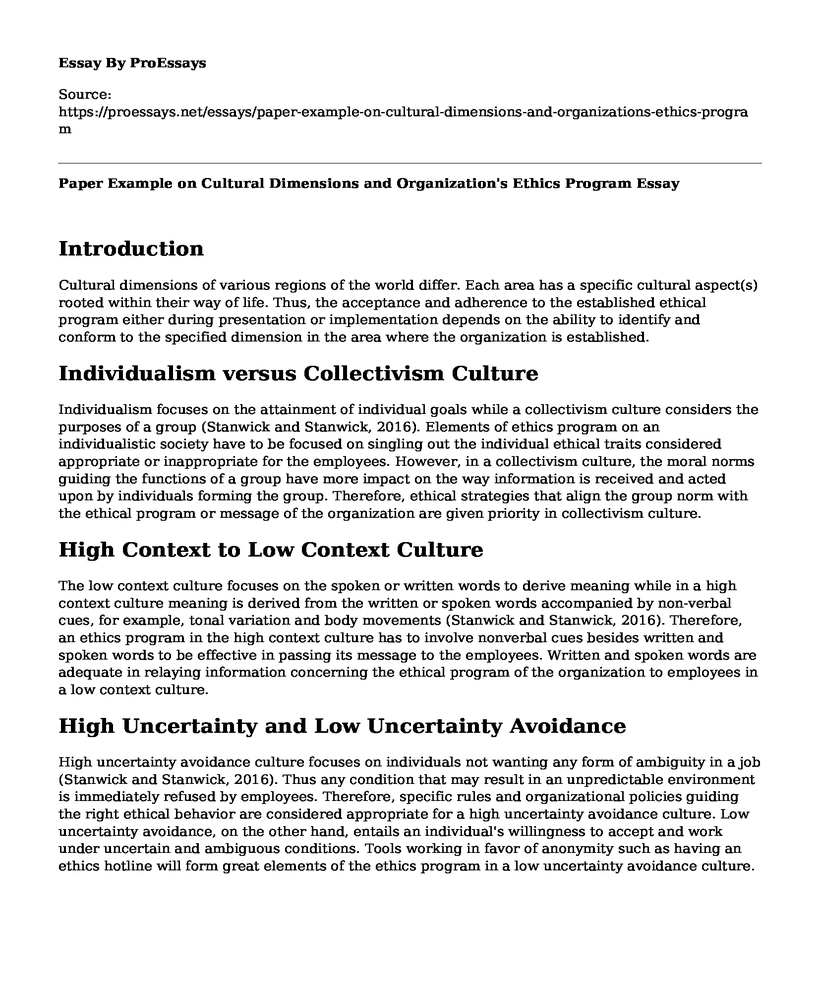Introduction
Cultural dimensions of various regions of the world differ. Each area has a specific cultural aspect(s) rooted within their way of life. Thus, the acceptance and adherence to the established ethical program either during presentation or implementation depends on the ability to identify and conform to the specified dimension in the area where the organization is established.
Individualism versus Collectivism Culture
Individualism focuses on the attainment of individual goals while a collectivism culture considers the purposes of a group (Stanwick and Stanwick, 2016). Elements of ethics program on an individualistic society have to be focused on singling out the individual ethical traits considered appropriate or inappropriate for the employees. However, in a collectivism culture, the moral norms guiding the functions of a group have more impact on the way information is received and acted upon by individuals forming the group. Therefore, ethical strategies that align the group norm with the ethical program or message of the organization are given priority in collectivism culture.
High Context to Low Context Culture
The low context culture focuses on the spoken or written words to derive meaning while in a high context culture meaning is derived from the written or spoken words accompanied by non-verbal cues, for example, tonal variation and body movements (Stanwick and Stanwick, 2016). Therefore, an ethics program in the high context culture has to involve nonverbal cues besides written and spoken words to be effective in passing its message to the employees. Written and spoken words are adequate in relaying information concerning the ethical program of the organization to employees in a low context culture.
High Uncertainty and Low Uncertainty Avoidance
High uncertainty avoidance culture focuses on individuals not wanting any form of ambiguity in a job (Stanwick and Stanwick, 2016). Thus any condition that may result in an unpredictable environment is immediately refused by employees. Therefore, specific rules and organizational policies guiding the right ethical behavior are considered appropriate for a high uncertainty avoidance culture. Low uncertainty avoidance, on the other hand, entails an individual's willingness to accept and work under uncertain and ambiguous conditions. Tools working in favor of anonymity such as having an ethics hotline will form great elements of the ethics program in a low uncertainty avoidance culture.
Masculinity and Feminity Culture
Masculinity culture is focused on status, results, and acknowledgment of efforts through rewards while feminity focuses on the importance of human needs, support for members and quality (Stanwick and Stanwick, 2016). Ethics program and information under a masculine culture should consider ethical programs aimed at monitoring and controlling the employees for individual punishment for unethical behavior. However, a feminist culture prefers non-punitive ethical programs to encourage ethical behavior.
High Power Distance and Low Power Distance
A culture that embraces a high power distance focuses on following the hierarchical structure established in the organization while under the low power distance culture employees contribute their ideas and thoughts freely about the activities of the organization (Stanwick and Stanwick, 2016). Low power distance employees are likely to be against any ethical program they feel is autocratic. Therefore, when implementing an ethics program, the level of influence and accountability is focused on higher management under high power distance while under low power distance, ethical programs accountability and blame is based on each employee's job responsibility.
Conclusion
Identifying and following the correct ethical dimension ensures that employees understand and adhere to the moral norms of the organization. Ensuring that the established ethical character and the consequences of not adhering to them can also be readily formulated.
References
Stanwick, A. Peter, and Stanwick, D. Sarah (2016). Understanding Business Ethics 3rd Edition. SAGE Publications
Cite this page
Paper Example on Cultural Dimensions and Organization's Ethics Program. (2022, Jun 24). Retrieved from https://proessays.net/essays/paper-example-on-cultural-dimensions-and-organizations-ethics-program
If you are the original author of this essay and no longer wish to have it published on the ProEssays website, please click below to request its removal:
- The Chinese Law Reform and Its Effect on the Australian Business
- Cancer Among Asian Americans Essay
- Essay Sample on Use of Native American Team Mascots
- The Potential Support That the Client Needs in Family Breakdown
- Impact of Alzheimer Disease on Family Patients Paper Example
- Achieve Goals & Live a Happy Life: Essay Sample on Aristotle's Moral Virtue
- Essay Sample on Impact of OAA & Raise Family Caregivers Act on U.S. Elderly Population







